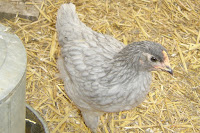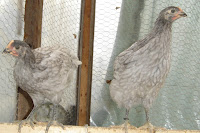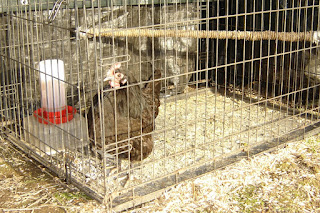A bit of McCackle as I update what I learn and discover while trying to raise chickens and garden.
Monday, April 15, 2024
Easy Pull Large Hoop Coop Design
Saturday, April 13, 2024
And then there were 25...
In February, we received 71 chicks from a no-kill, NPIP hatchery located in the Midwest. I have been really pleased with this hatchery. I have received three batches from them. The health of the chicks are very good when they arrive. As with any hatchery situation, there are bound to be a few that fail to thrive, but so far, with this hatchery, we usually only lose one or two.
Last weekend, we rehomed 45 of the chicks at the ages of six weeks and seven weeks. We have 25 left. 15 of those are promised out for rehoming over the next three weeks. That will leave us with 10 of the originals received in February. Fingers crossed that none are roosters this year.
Two of this year's originals do have some health issues. One has a cervical deformity that does not seem to slow her down as she is growing at the seem rate at the rest, she just looks a bit odd. The others don't seem to notice her deformity. Then we have a dwarfish pullet. A Rhode Island Red. She is fast but has been picked on a little, with some feathers missing from her backside. She will stay with us on the farm. She's not slow or sluggish like the dwarf we had a couple years ago. She may simply be more like a bantam.
Next week, we will pickup 50ish Cornish Rock Crosses, and six pullet Color Pack Blue Layers that we will likely keep for ourselves but may rehome some at six weeks.
Hen Survived Impacted and Sour Crop - Treatment We Used
I kept a diary of the process of treating (but almost culling) our hen who had a softball sized impacted crop that we discovered a month ago. Honestly, really thought we were going to need to put her out of her misery after the first few days. Anyways, I'm sharing my diary for others who may find it useful.
Please forgive any typos... I don't plan to "fix" the original errors on the diary.
NOTE-I am not a Veterinarian, or Vet Tech, or trained in medical procedures. Use my research at your own risk.
~~**~~**~~**~~**~~**~~**~~**~~**~~**~~**~~**~~**~~**~~**~~**~~**~~
March 18 - Discovered Hen has impacted crop and sour crop - Isolated her with just water and vitamins - no food. No access to any grass, etc., that she might try to ingest. We did have some hemp shaving on the floor of the crate that she seemed to claw at and flip out of the crate. She had clawed most of the feathers off her breast from her discomfort.
*I will point out that, unlike about 50% of the online suggestions for sour crop, I did not turn my hen upside down to try to drain her at any point in this healing process. We don't have poultry veterinarians in the region, and even with surgery, there is no guarantee of survival, although, I'm certain that it would minimize the distress of both the chicken and the chicken owner, and have been a quicker process, if the bird survived the surgery.
March 19 - Crop was still very distended and a baseball sized mass all bound with rough edges - still no food - No poohs from overnight. Gently massaged to "reshape" the mass throughout the course of the day being careful not to force anything up her esophagus.
March 20 - Day two - No poohs. Crop felt less distended but mass still pretty large. Hen drank vitamin water only and we gave about 3cc of olive oil through her beak using method of lifting her head and holding it gently extended while opening the beak and squirting a little down the side of her throat a little at a time, giving her the ability to swallow between each small amount. No food offered. - Gently massaged to "reshape" the mass throughout the course of the day being careful not to force anything up her esophagus.
March 21 - She's in distress although her comb color and eyes are bright. We are preparing to cull her to end her distress. The course of the day was similar to yesterday; vitamin water, olive oil, massage, and trying to reassure her. Gave her some of the smallish pieces of #2 grit.
March 22 - Situation Change - She poohed some green stuff! Gave her another small amount of the smaller grit, more fresh water with vitamins. Not ready to cull just yet. The Oil and Massage routine again. She's feisty today.
March 23 - She poohed again and eat some scrambled eggs coated in Olive Oil today. A little more grit offered. *Picked up Monistat 7 per a sour crop treatment recommendation on Murano Chicken Farm Blog. Her eyes are still bright but her comb has spots of white on the tips. Making certain to remove any food at the end of each day so that we are treating her with Monistat in the morning without new food in her crop.
Note - when she started eating wet-ish food, we would put the olive oil over the food and she would ingest the oil without the distress of us drippling it down her throat. She got to the point of actually licking the oil off the plate! So, even though it is not mentioned every day, olive oil was part of the feeding process everyday until the 4th week.
March 24 - Mass is getting smaller than original and softer. The mass was easier to massage and move. Not massaging as often. Only twice per day. Gave 0.5cc Monistat the same way we were giving her olive oil. Tried to give her scrambled eggs an hour after the medication but she would not eat it. Gave her more grit. She ate a handful of grit. Removed the food at bedtime.
End of Week 1
March 25 - Poohed again. Mass is about half the size - still softish. Gave her morning dose of Monistat, massaged mass, and gave her some canned catfood with a tablespoon of olive oil. She ate the catfood. Fresh water with RACV. She ate a little grit.
March 26 - Situation Change again. Poohed again. Mass has become smoother, got much smaller, and a lot softer. Morning dose of Monistat, gentle massage and hour later gave her cat food with oil, but only ate a little. Another massage. More grit. Food removed at bedtime.
March 27 - Started a ferment of chick starter feed. She had another Pooh overnight. Used same routine as yesterday. Wouldn't eat cat food or eggs, but did eat a little of the dry chick start feed. Not much. Did eat some more grit.
March 28 - A BIG green pooh today! Each day noticing the mass is getting smaller. Same morning routine with Monistat on empty stomach, gentle massage. Ate a little cat food with oil. Seems a bit more alert. Gentle massage in the evening with small amount of grit. Continuing to remove any leftover food each night.
March 29 - Started another batch of fermented food as a backup just in case she likes it. Another green pooh overnight. The mass is a lot smaller and almost the size of walnut. Same morning routine, massage, and fed the fermented chick feed (about 2 tablespoons) with tablespoon of olive oil. She loved it! Gave her one more tablespoon of the fermented feed. She cleaned it all up. Gentle massage, grit and remove food plate.
March 30 - Started another batch of fermented food. More pooh that became more brownish in color. The same morning routine. Last Dose of Monistat. Gave her more grit. Fed her the next batch of fermented feed BUT she did not want it. (later realized it was not "fermented" long enough she only likes the feed if it has fermented between 60 to 72 hours)
March 31 - Started another batch of fermented food. Mass is all gone! Crop is flat, and nothing to massage. Coloring in her comb is back to a bright pink. Eyes are still bright. She ate a little dry chick starter. Removed food at bedtime.
End of Week 2
April 1 - Keeping the fermenting process going daily until I know for certain that she is all better. No new pooh. No mass but her crop feels like it is full of jelly, even though she had no food this morning. Gently massaged it. Did More Sour Crop research. Refreshed her water with RACV (3/4 tsp/quart). More grit. She wouldn't eat the fermented food with olive oil today. Gave her some scratch in olive oil and she ate a little. Removed food at bedtime.
April 2 - Watery reddish pooh overnight. The bubble of watery stuff still in her crop. Comb still nice and pink. Eyes still bright. Back to the Monistat treatment. She ate more grit and a couple tablespoons of the fermented feed along with a tablespoon of oil added. (Note - oil is not used in the fermentation process).
April 3 - A little watery pooh. More Monistat and she ate four tablespoons worth of the ferment, 2 tablespoons in the morning and 2 more in the afternoon, finishing both before bedtime.
April 4 - Several big firm poohs, some green and some brown. Another dose of Monistat. She ate more grit, and six tablespoons of the fermented feed with olive oil over the course of the day.
April 5 - A small watery pooh. The jelly bubble is a lot smaller. Another dose of Monistat. She ate six tablespoons of the fermented feed over the course of the day.
April 6 - A very large watery pooh. The jelly bubble was gone this morning! Another dose of Monistat. She ate more grit and eight tablespoons of the fermented feed over the course of the day.
*I did learn there are some other digestive aids that can improve chicken's sour crop is teaspoon or two of Pomegranate Juice added to their water, and small amount (1/8 tsp) of cinnamon bark liquid extract (not essential oil) added to their feed. Two separate researches were done on Broilers in the past 10 years, and both studies found that these supplements helped reduce yeast growth in the chickens' digestive systems without antibiotics because of the anti-microbial nature of the pomegranate and cinnamon bark. It took me a while to find these two suggested items in formats that were straight and undiluted. I will supplement with these items over the next week even though, in truth, I think we have her on the mend. We will try the supplements while she is still on the Monistat, and then start to use pro-biotics after we are certain we have the sour crop under control, and no longer need the Monistat or other anti-microbial supplements. Although fermented feed has some probiotics, there is no guarantee that there are enough probiotics in the feed alone, so I will supplement with chick pro-biotics starting in about two to three days while starting to wean her off the pomegranate and cinnamon extract as the week progresses. I have discovered that I can refrigerate any extra three day fermented feed and she will still eat it the next day like it was freshly fermented! Yay!
April 7 - Several large dark brownish poohs overnight. Another flat chest start to the day. One last dose of the Monistat. Fed 10 tablespoons of fermented chick start feed adding a few drops of cinnamon bark liquid extract to the feed during the last feeding. A mid-day pooh that looked more normal. She acts like she is starving, which is encouraging, although I don't want to over feed her at this point. But she is eating all the mash that is given, and taking in a few grains of grit, as well, even though she doesn't need grit with the fermented mash. I will give her some scratch tonight just before bedtime. Fingers crossed. I was able to find some chick pro-biotics that I can add to her feed tomorrow, now that she is off the Monistat.
End of Week 3
April 8 - Good poohs over night that looked more normal. Still no sign of sour crop. Added Cinnamon Bark extract in addition to a sprinkle of probiotics to her fermented mash. No Olive Oil at this point. She ate two big helpings of about 1/3 cup each and then ate some dry chick crumbles. Late in the afternoon, gave her more grit and a handful of grains. Full crop and not spongy.
April 9 - More good poohs over night. Still no sign of sour crop. No Cinnamon Bark extract today, just a sprinkle (1/8th teaspoon) of probiotics over her fermented feed servings. She ate about 2/3 cup of the fermented feed plus several small scoops of all purpose poultry pellets. Not been adding any oystershell nor extra calcium to her diet. Just trying to get her healthy. Have noticed that the luster shine in her feathers has returned.
April 10 - Another great morning. Ate almost a cup of fermented mash and some more pellets. She is putting weight back on and she is more attentive, pacing, wanting to go back to her group. More chatty.
April 11 - Doing really well. Had refeathered her breast area. Ate about 6 to 8 ounces of fermented feed and then ate some pellets to top off her day. She is lonely. She looks quite healthy now. Placed her back in the flock in the evening after sunset.
April 12 - Hen is back in the flock today. Although her crop protrudes more than it used to, it is digesting fully over night. She is readjusting to the group.
April 13 - Looking really good. Will keep a close eye on her over the next week, just in case.
Took almost four weeks!
~~**~~**~~**~~**~~**~~**~~**~~**~~**~~**~~**~~**~~**~~**~~**~~**~~
These are some of the items I used to treat the hen over the course of the past month.
 Generic Monistat (Miconazole 7) 0.5cc oral each treatment using 1.0mL needleless syringes. First thing in the morning, on an empty stomach and waited one hour before feeding any food.
Generic Monistat (Miconazole 7) 0.5cc oral each treatment using 1.0mL needleless syringes. First thing in the morning, on an empty stomach and waited one hour before feeding any food.  Bragg Organic Apple Cider Vinegar, 0.75 teaspoon/quart water on days I didn't use Nutri drench or Pomegranate Powder.
Bragg Organic Apple Cider Vinegar, 0.75 teaspoon/quart water on days I didn't use Nutri drench or Pomegranate Powder.  Poultry Probiotic, 0.125 (1/8th) teaspoon per 2 - 3 oz. serving of fermented feed daily, starting the day after ending the Monistat treatments. I did not add the probiotics to the water.
Poultry Probiotic, 0.125 (1/8th) teaspoon per 2 - 3 oz. serving of fermented feed daily, starting the day after ending the Monistat treatments. I did not add the probiotics to the water.
























